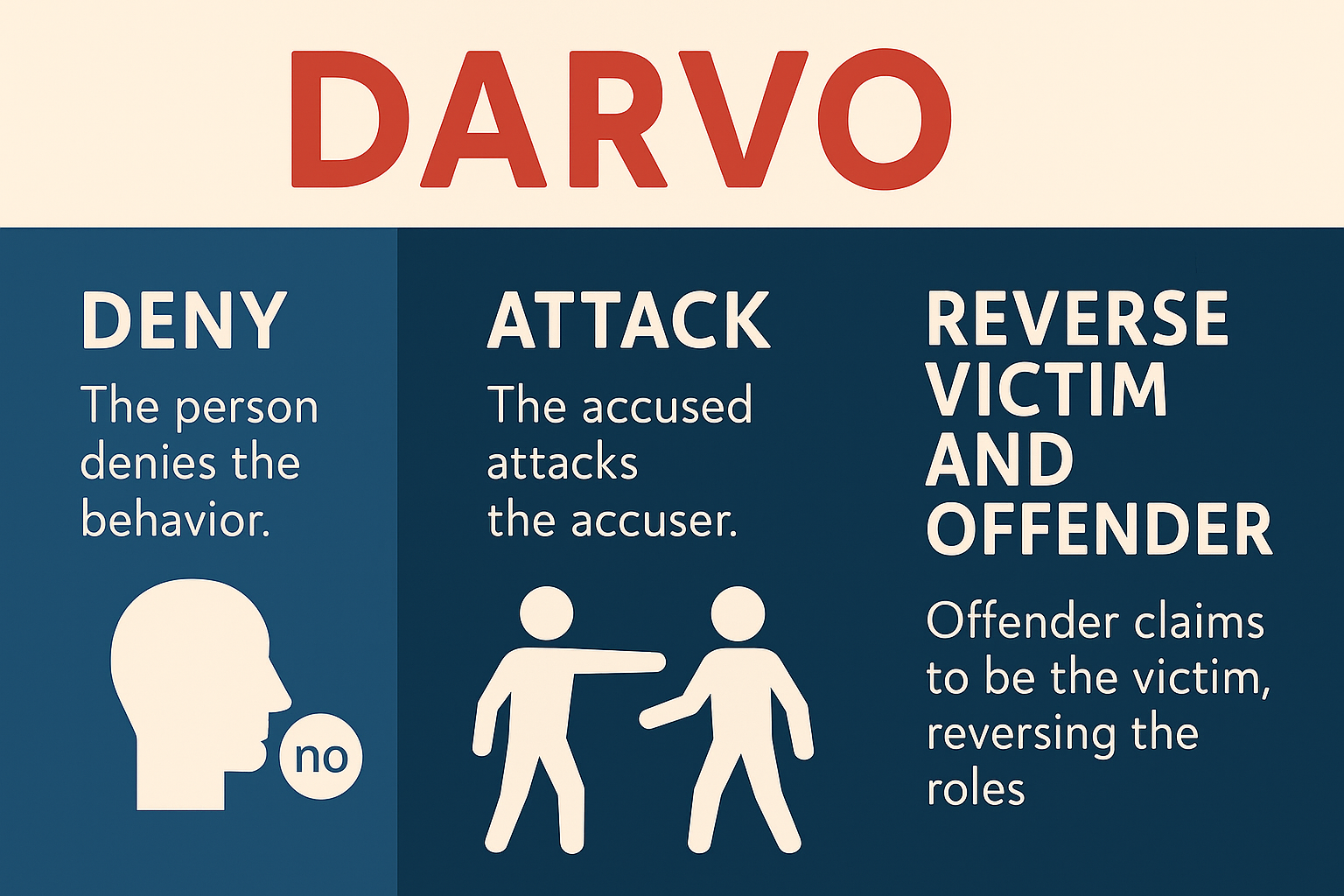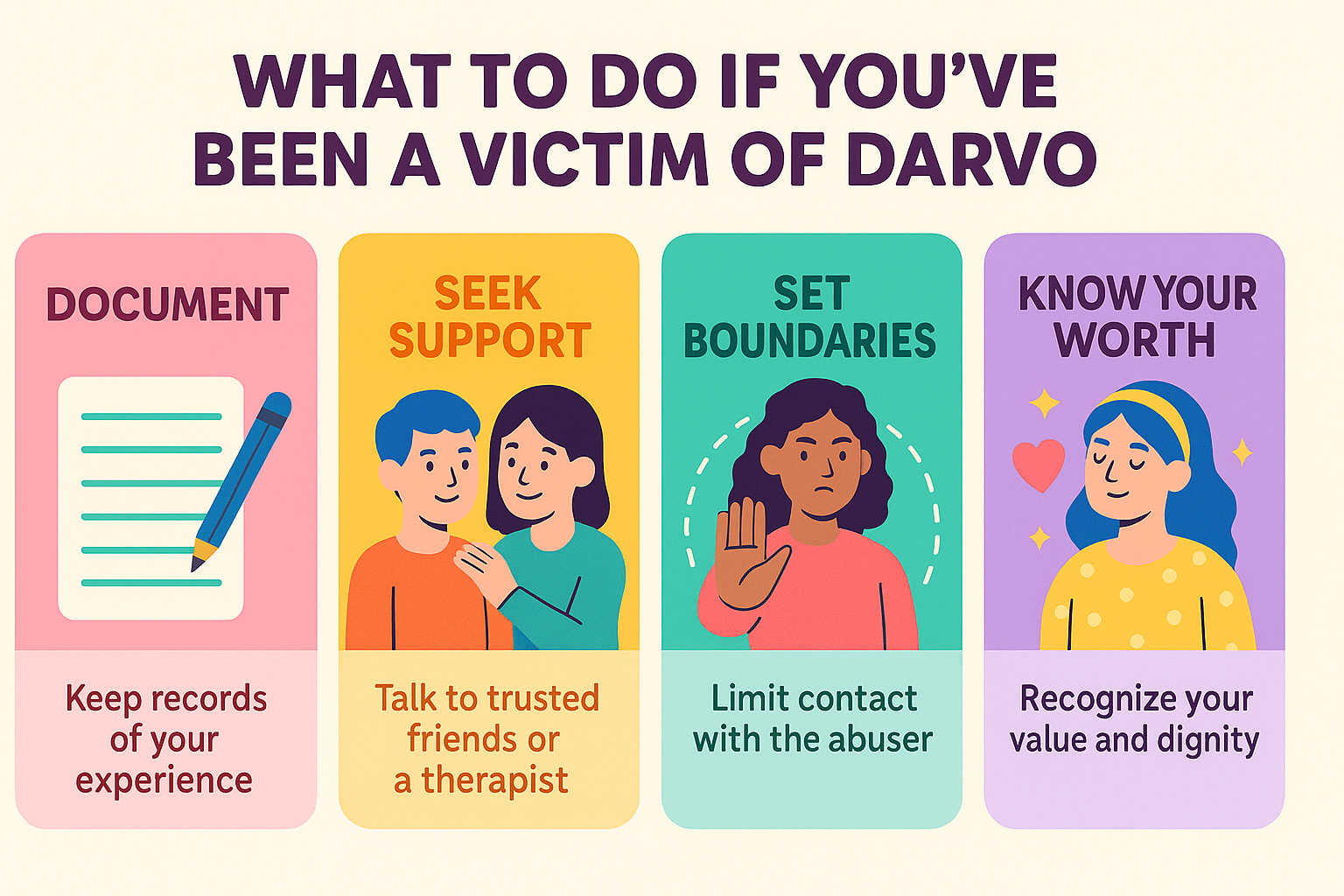DARVO: Recognize It, Stop It, Protect Yourself
Have you ever found yourself in a situation where you were accused of something you didn’t do, or your emotions were dismissed when you tried to speak up about being hurt?
If so, you might have experienced a tactic known as DARVO.
This powerful manipulation strategy is commonly used by abusers to avoid taking responsibility for their harmful actions. But understanding how DARVO works can help you protect yourself and respond in healthier ways.
What is DARVO?
DARVO stands for Deny, Attack, Reverse Victim and Offender. It is a psychological manipulation tactic used to avoid accountability. Here's how it works:
Deny: The person responsible for harm denies any wrongdoing. They might refuse to admit what happened or minimize the impact of their actions.
Attack: After denying the wrongdoing, the abuser shifts focus and attacks the victim. This can include blaming the victim, questioning their motives, or accusing them of being the one in the wrong.
Reverse Victim and Offender: Finally, the abuser portrays themselves as the real victim and flips the narrative. They try to make it seem like they are the one being mistreated or misunderstood, often to gain sympathy or avoid the consequences of their actions.
This tactic can be used in many types of relationships, including romantic, familial, and even professional settings. It’s a common strategy in cases of domestic violence, sexual assault, and gaslighting.
How DARVO Was Developed
The term DARVO was coined by Dr. Jennifer Freyd, a psychologist at the University of Oregon, in the 1990s.
Dr. Freyd’s research on betrayal trauma—the kind of trauma that happens when the people we trust most harm us—led her to recognize this pattern in abusive relationships.
She noticed that abusers would often manipulate victims by denying the abuse, attacking the victim, and then reversing the roles to paint themselves as the innocent party.
Understanding this concept helps to shed light on the dynamics of abusive relationships, making it easier to spot the signs and break the cycle.
Research on DARVO's Efficacy
Research has shown that DARVO is not just a theoretical concept—it’s a real and effective tool used by abusers to manipulate their victims and confuse others about the truth.
A 2022 study by Freyd and colleagues surveyed college students and found that approximately half of those who had experienced sexual assault reported that the perpetrator used DARVO tactics during the aftermath. This manipulation led victims to feel confused and question their own experiences, often leading to self-blame.
Another Freyd study in 2023 showed that DARVO can change how observers perceive a situation. In this study, participants read a sexual assault scenario and found that when DARVO was used by the abuser, they rated the abuser as less responsible and the victim as more at fault. This highlights how DARVO can affect not just the victim but also people outside of the situation, such as friends, family, or even juries.
Furthermore, a 2024 study showed that DARVO is associated with rape myths—misconceptions that blame victims for the abuse or make light of the harm caused. The study found that people who accept these myths are more likely to use DARVO tactics or fail to hold abusers accountable.
What to Do if You’ve Been a Victim of DARVO
If you recognize that you’ve been a victim of DARVO, it’s important to take steps to protect yourself and reclaim your power. Here are a few strategies:
Trust Your Experience: The first step in dealing with DARVO is to trust your feelings and your version of events. Manipulators want to make you question yourself, but your experiences and emotions are valid.
Set Boundaries: Recognizing DARVO allows you to set clearer boundaries with the person using this tactic. You can calmly state that you will not tolerate manipulation and distance yourself from the situation.
Seek Support: It can be incredibly difficult to navigate a relationship with someone using DARVO. Talk to a trusted friend, therapist, or counselor who can help you process the situation and provide validation.
Document the Abuse: Keep a record of what happens when you are manipulated with DARVO. Documenting the events can help you see patterns, which is especially important if you need to seek legal or professional help.
Educate Yourself: The more you know about DARVO, the better you can identify it when it happens. Understanding that this tactic exists will make it easier to spot and respond effectively.
Conclusion
DARVO is a harmful manipulation tactic that can cause emotional distress, confusion, and self-doubt in victims. By understanding how it works and recognizing the signs, you can protect yourself from being manipulated.
Remember, you deserve to be heard, believed, and respected in all of your relationships. If you’ve experienced DARVO, don’t hesitate to reach out for support.
Research Citations
Freyd, J. J., & Rosenthal, M. (2022). College women's contact with their perpetrators after sexual assault. Journal of Aggression, Maltreatment & Trauma, 31(5), 1–19.
Harsey, S. J., & Freyd, J. J. (2023). The influence of deny, attack, reverse victim and offender and insincere apologies on perceptions of sexual assault. Journal of Interpersonal Violence, 38(17-18), 9985–10008.
Harsey, S. J., Adams-Clark, A. A., & Freyd, J. J. (2024). Associations between defensive victim-blaming responses (DARVO), rape myth acceptance, and sexual harassment. PLOS ONE, 19(12), e0313642.
If you need immediate support, you can contact the National Sexual Assault Hotline at 800.656.HOPE (4673) or visit online.rainn.org for confidential assistance.


